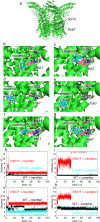Structural basis for promiscuous action of monoterpenes on TRP channels
- PMID: 33674682
- PMCID: PMC7935860
- DOI: 10.1038/s42003-021-01776-0
Structural basis for promiscuous action of monoterpenes on TRP channels
Abstract
Monoterpenes are major constituents of plant-derived essential oils and have long been widely used for therapeutic and cosmetic applications. The monoterpenes menthol and camphor are agonists or antagonists for several TRP channels such as TRPM8, TRPV1, TRPV3 and TRPA1. However, which regions within TRPV1 and TRPV3 confer sensitivity to monoterpenes or other synthesized chemicals such as 2-APB are unclear. In this study we identified conserved arginine and glycine residues in the linker between S4 and S5 that are related to the action of these chemicals and validated these findings in molecular dynamics simulations. The involvement of these amino acids differed between TRPV3 and TRPV1 for chemical-induced and heat-evoked activation. These findings provide the basis for characterization of physiological function and biophysical properties of ion channels.
Conflict of interest statement
The authors declare no competing interests.
Figures







Similar articles
-
Camphor activates and sensitizes transient receptor potential melastatin 8 (TRPM8) to cooling and icilin.Chem Senses. 2013 Sep;38(7):563-75. doi: 10.1093/chemse/bjt027. Epub 2013 Jul 4. Chem Senses. 2013. PMID: 23828908
-
Transient receptor potential (TRP) channels: a clinical perspective.Br J Pharmacol. 2014 May;171(10):2474-507. doi: 10.1111/bph.12414. Br J Pharmacol. 2014. PMID: 24102319 Free PMC article. Review.
-
Conserved residues within the putative S4-S5 region serve distinct functions among thermosensitive vanilloid transient receptor potential (TRPV) channels.J Biol Chem. 2010 Dec 31;285(53):41455-62. doi: 10.1074/jbc.M110.145466. Epub 2010 Nov 2. J Biol Chem. 2010. PMID: 21044960 Free PMC article.
-
Camphor modulates TRPV3 cation channels activity by interacting with critical pore-region cysteine residues.Pak J Pharm Sci. 2013 May;26(3):431-8. Pak J Pharm Sci. 2013. PMID: 23625413
-
The S4---S5 linker - gearbox of TRP channel gating.Cell Calcium. 2017 Nov;67:156-165. doi: 10.1016/j.ceca.2017.04.002. Epub 2017 Apr 4. Cell Calcium. 2017. PMID: 28416203 Review.
Cited by
-
Menthol in Livestock: Unveiling Its Multifaceted Properties and Future Potential for Sustainable Agriculture.Int J Mol Sci. 2025 Mar 17;26(6):2679. doi: 10.3390/ijms26062679. Int J Mol Sci. 2025. PMID: 40141321 Free PMC article. Review.
-
TRPV3: Structure, Diseases and Modulators.Molecules. 2023 Jan 12;28(2):774. doi: 10.3390/molecules28020774. Molecules. 2023. PMID: 36677834 Free PMC article. Review.
-
Effects of camphor and related compounds on slowly adapting mechanoreceptors in the rat sinus hair follicle.IBRO Neurosci Rep. 2022 Jul 19;13:114-119. doi: 10.1016/j.ibneur.2022.07.002. eCollection 2022 Dec. IBRO Neurosci Rep. 2022. PMID: 35899231 Free PMC article.
-
The Impact of a Quinone Scaffold on Thermo-TRPs Modulation by Dimethylheptyl Phytocannabinoids.Int J Mol Sci. 2025 Mar 17;26(6):2682. doi: 10.3390/ijms26062682. Int J Mol Sci. 2025. PMID: 40141324 Free PMC article.
-
The distinctive role of menthol in pain and analgesia: Mechanisms, practices, and advances.Front Mol Neurosci. 2022 Oct 5;15:1006908. doi: 10.3389/fnmol.2022.1006908. eCollection 2022. Front Mol Neurosci. 2022. PMID: 36277488 Free PMC article. Review.
References
Publication types
MeSH terms
Substances
LinkOut - more resources
Full Text Sources
Other Literature Sources

